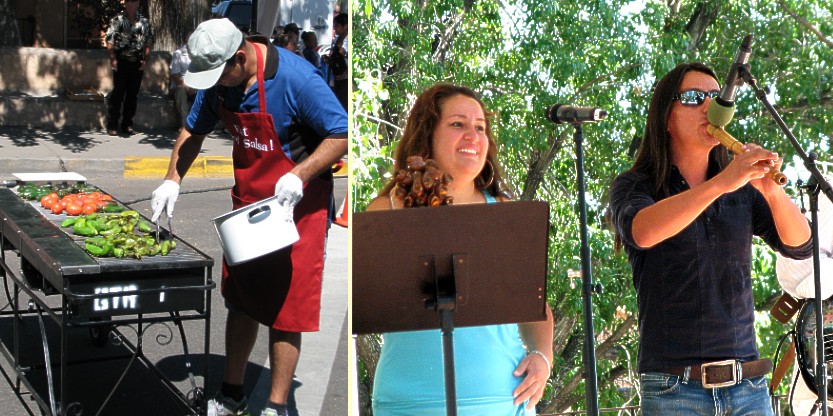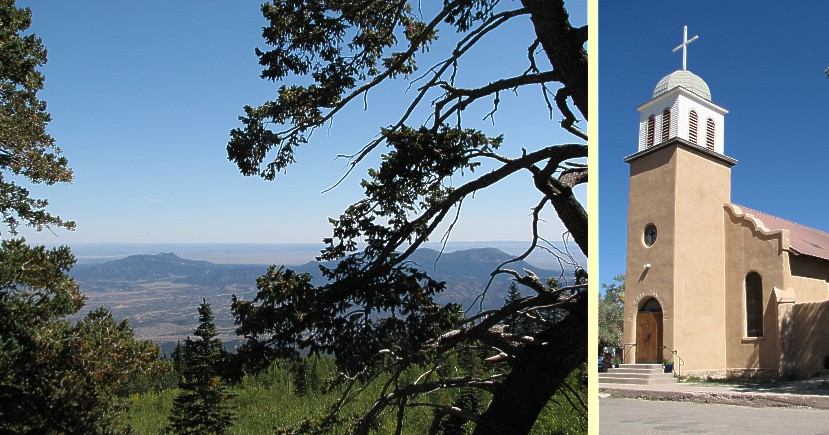
Kansas Snapshots by Gloria Freeland - Oct. 7, 2011
The Land of Enchantment
As our plane touched down in Albuquerque, we were struck immediately by the contrast between the bright blue sky and golden earth.
We had heard that the city was well designed and we got a hint of that as soon as we set off to pick up our rental car. Rather than each of the companies having separate shuttle buses, one took all passengers to the adobe-colored building that housed the various agencies. The roadway median leading from the airport was decorated with giant Native American pots and cacti.
Once in our car, we drove to Hotel Albuquerque - our home for the next four days and center for the conference I was attending.
Heavy dark-wood furniture, reminiscent of Spanish colonial times, filled the large lobby and convention foyers. In the courtyard, tables and chairs - leather stretched across them - sat around the perimeter. Rocking chairs were sprinkled here and there and vine-covered trellises offered shade from the bright sun. The soft spray of fountains soothed the ears.
Our room seemed intimate and comfortable. The furniture had a rustic appearance but felt luxurious. Our room was on the 8th floor and had a balcony that looked out over the city. Every morning when I walked barefoot onto it, I was amazed at how cool to the touch the stone was, yet every evening when I went out to watch the sunset, it felt warm. Albuquerque has few tall buildings, so the city seemed smaller than Kansas City, despite being about the same size.
The name Alburquerque came from a town in Spain's Badajoz province. Its origin dates from the time the Moors lived in the south of the country and may have been the Arabic "Abu al-Qurq," which means "land of the cork oak," or "Al-Barquq," which means "the plum."
In 1706, Spanish colonists moving north from Mexico established a city on the banks of the Rio Grande. The colony's governor, Francisco Cuervo y Valdez, wrote to the Duke of Alburquerque to tell him about the founding of the town named in the Duke's honor.
Albuquerque - the first "r" in the name was later dropped - was built in the traditional Spanish village pattern with a central plaza surrounded by government buildings, homes and a church. The San Felipe de Neri church, built in 1793, is one of the oldest surviving buildings in the Old Town section of the city. It was just two blocks south of our hotel.
A friend had recommended the Seasons Rotisserie and Grill and, by the time we had unpacked, we were both ready to try her suggestion.
Art spotted the pancetta-wrapped grilled figs on the appetizer menu. We had no idea what they would taste like, but when Art asked if I wanted to try them, I laughed and said, "Why not? Let's live large." They turned out to be fantastic, as was my fish and Art's steak.
Friday was a full convention day for me, but in the evening we enjoyed a Southwest meal and Native American dances at the Indian Pueblo Cultural Center. Its mission is to preserve and perpetuate the culture and history of New Mexico's 19 pueblos and the people who populated the Rio Grande Valley long before Europeans arrived.
The next morning, we headed to Old Town again, this time to take in the annual Salsa Festival. It's a celebration of the harvest of the red and green chili peppers. Strings of red peppers hung from building entrances and in courtyards. On the perimeters of the central plaza, contestants roasted them and then mixed them with their own special ingredients. For $4, a person could taste them all and then vote for their favorite. But Art and I decided to limit our chili intake to the ones on our chimichangas and sopapillas at La Hacienda, a restaurant on the corner of the plaza.
The festival is also about Latin American music. Several groups performed at different venues in Old Town, but "Encuentro" - Spanish for encounter - caught our attention. Made up of musicians from Mexico, Peru and Bolivia, their lively tunes caused folks to get up and dance.
I had to return to the conference in mid-afternoon, but Art stayed on until it was time for our evening adventure. It involved a 15-minute, 2.7 mile ride on an aerial tramway up the western face of the 10,378-foot Sandia Peak. In the fading light of the day, the rocks became a soft watermelon color, fitting since sandia is the Spanish word for watermelon.
By the time we returned, night had set in and the twinkling lights of Albuquerque were spread out below us.
On Sunday, Art and I hit the Turquoise Trail, a 60-mile jaunt on Highway 14 between Albuquerque and Santa Fe. At San Antonito, we took a detour up the eastern face of the Sandia Mountains. The orange, purple, red and white wild flowers were beautiful mixed with the green pines and yellow aspens.
Back on the trail, we stopped along the road to take pictures of the cacti and then spent some time in Madrid, an old mining town converted into an artists' community. We ordered chocolate malts at an old soda fountain and browsed several shops. Then we moved on to Cerrillos, which had one of the oldest turquoise and lead mines in the Southwest. Its dirt streets and old church made it seem as if we had just stepped onto the set of a Western movie.
Late in the afternoon, we headed back to Albuquerque, our adventure to the Southwest nearly over. The weather had been unbeatable - clear and calm with temperatures in the high 70s during the day and in the 50s at night. The mix of Western European, Native American, Mexican and Latino cultures was fascinating. And the colors - the soft pastels of the morning light and the jewel tones of the evening - were spellbinding.
For us, New Mexico had lived up to its nickname - it was indeed a Land of Enchantment.

Left: A contestant prepares salsa ingrediants for the contest; right: Two
musicians from the group "Encuentro" entertaining festival attendees.

Left: View to the east from the Sandia Mountains; right: the old church in Cerrillos.
Comments? [email protected].
Earlier columns from 2011 may be found at: 2011 Index.
Links to previous years are on the home page Home